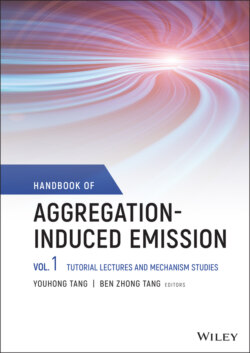Читать книгу Handbook of Aggregation-Induced Emission, Volume 1 - Группа авторов - Страница 34
2.3.1 Rotating Vibrations of Intramolecular Aromatic Ring
ОглавлениеSiloles (silacyclopentadines) are the first kind of AIEgens [4, 45, 46]. The first silole molecule where the ΦF in both gas phase and crystal are quantitatively investigated is HPS (Figure 2.3) [37]. HPS is poorly luminescent in cyclohexane at room temperature with a ΦF as low as 0.30%, while in thin film, the ΦF reaches 78% [45]. Combining QM and QM/MM calculations, the structural change analysis of optimized structures between S0 and S1 reflects that the torsional angles between the central silacycle and phenyl groups at the 2,5‐positions show larger modifications (14.56° and 14.63°) in the isolated state than those (5.85° and 1.05°) in solid phase, suggesting that the geometric relaxations of the phenyl rings at the 2,5‐positions are largely hindered in the solid phase. Moreover, the dihedral angle between the central silacycle and the phenyl ring at the 5‐position decreases, which strengthens the intramolecular conjugation, resulting in the increase of the electric transition dipole moment (μ) from 5.20 to 5.85 Debye (Table 2.1). Hence, upon aggregation, the calculated kr increases 6 times, while kic decreases about 4 orders of magnitude (Table 2.1). The nonradiative decay channels are generated by the coupling between the electrons and thermal vibrations that can be quantified by the molecular reorganization energy for the ith vibrational mode and , which is very sensitive to the surrounding environment. As seen, λtotal for HPS in the solid phase (403 meV) is obviously smaller than that in the gas phase (492 meV). The decrease in λtotal mainly stems from the low‐frequency vibrational modes (see Figure 2.4a), which are assigned to the rotating vibrations of the phenyl rings at the 2,5‐position. Thus, the excited‐state energy dissipation pathways are easily restricted via the decoupling between the electron and low‐frequency out‐of‐plane rotating modes in aggregates (see Figure 2.2b). The corresponding theoretically calculated ΦF in the gas phase and solid phases is 0.003 and 76% (see Table 2.1), respectively, consistent with experimental results [45]. This well explains the bright emission of HPS in aggregate phase.
Figure 2.2 (a) PES scheme of AIEgens in solution and solid states. (b–g) Overview of vibrational modes involved in the excited‐state nonradiative decay channels, which contribute to AIE.
A similar AIE mechanism is followed by the other siloles, with the degree of π‐conjugation of the 2,5‐substituents increasing from TPS [47], BrTPS [48], HPS [45], BTPES [48] to BFTPS [49] (Figure 2.3). As shown in Table 2.1, as the conjugation increases, ∆Eg in both gas phase and solid state decreases regularly. Simultaneously, the μ value increases drastically due to the electron delocalization. The balance of excitation energy and μ makes kr to first increase and then levels off as the extension of conjugation from TPS to BFTPS. After aggregation, λtotal for all AIEgens decreases obviously and kic decreases by more than 2 orders of magnitude from 9.30 × 105 s−1 for TPS to 1.22 × 108 s−1 for BFTPS. Overall, with the degree of π‐conjugation of the 2,5‐substituent increases, ΦF in the solid state first increases sharply, then levels off, and finally starts to decrease slightly, as the competition between kr and kic. Similar to the above discussed HPS, the dramatic decrease of kic upon aggregation turns the fluorescence on, which is mainly caused by the decoupling of the electron and low‐frequency rotational normal modes (Figure 2.4a) [38].
Figure 2.3 Overview of molecular structures discussed in Sections 2.3 and 2.4.
